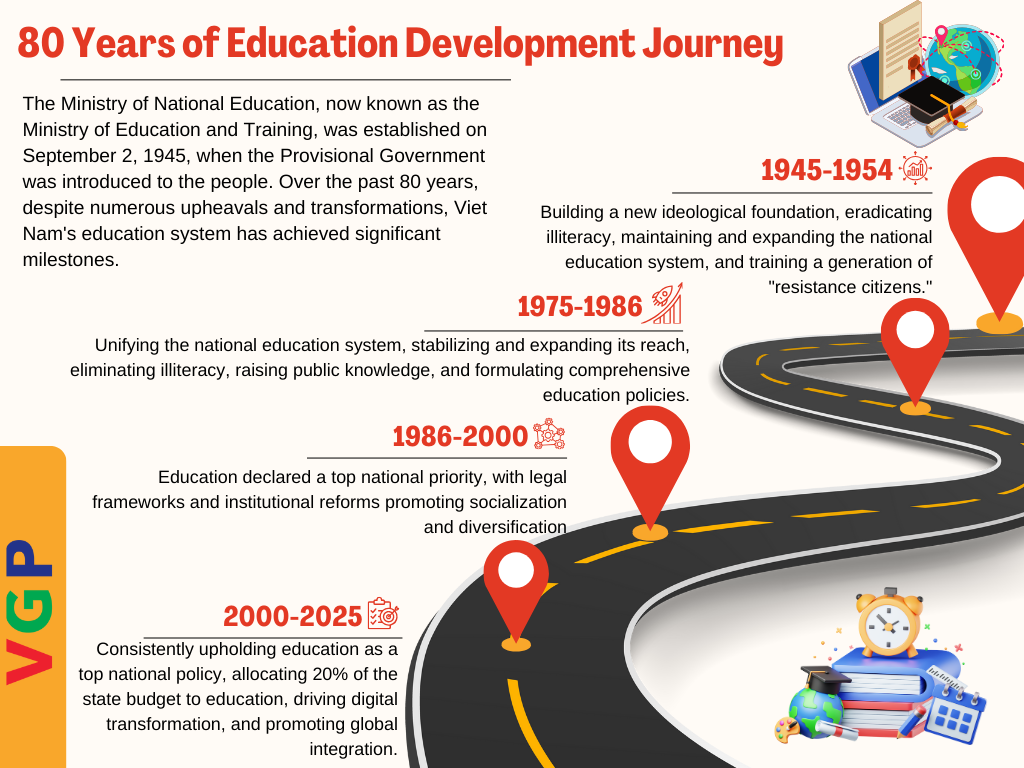Viet Nam’s 80-year education journey: From illiteracy to internationalization
VGP - From mass illiteracy in the aftermath of war in 1945 to the current era of global integration, Viet Nam’s education system has undergone five transformative phases over the past eight decades.

The Ministry of National Education — now the Ministry of Education and Training — was founded on September 2, 1945, alongside the birth of the Provisional Government. Despite wars, upheavals, and periods of crisis, the system has consistently evolved, leaving a profound imprint on the nation's development.
1945–1954: Foundations and Illiteracy Eradication
In 1945, more than 90 percent of Viet Nam's population could not read or write. Amid economic collapse and existential threats, the government prioritized literacy. Movements for adult education flourished in liberated zones, schools reopened, and universities resumed teaching in Vietnamese.
In occupied areas, education became a battleground of ideology. While the French colonial administration sought to suppress revolutionary ideas through its school system, underground classes maintained literacy efforts. Schools also became centers of surveillance, repression, and resistance.
1954–1975: Divergent paths in the north and south
After the Geneva Accords, the country was divided, leading to contrasting education models.
In the North, illiteracy was nearly eliminated through a third major campaign. The 1956 reform introduced a 10-year general education system, standardized curricula, and professional teacher training. Education was tied to socialist construction, with curricula emphasizing labor and practical skills. Universities expanded rapidly despite wartime bombings.
In the South, two systems coexisted: one under the Republic of Viet Nam and another in liberated zones. Revolutionary education thrived, particularly after 1961, with its own curricula and textbooks. By the late 1960s, schools spread widely in semi-legal and legal forms, especially following the Paris Peace Accords.
1975–1986: National Unification and Comprehensive Reform
Following reunification, education focused on stabilizing and unifying institutions across the country. By 1978, illiteracy was largely eradicated in the South, and most private schools were absorbed into the public system. Postgraduate education was also introduced.
Resolution 14 (1979) launched the third comprehensive education reform, establishing a unified 12-year system with standardized curricula. However, the economic crisis of the 1980s strained the sector. Funding was limited, classrooms were makeshift, and teachers faced severe financial hardship. Despite these challenges, the ideological foundation — "education is the cultural backbone of a nation and the strength of its future" — was affirmed.
1986–2000: Education as a National Priority
With the Doi Moi reforms, education was officially declared a "top national policy." Resolution 6 (1989) called for diversification, expansion of non-public schools, and mixed financing models.
The 7th Party Congress (1991) highlighted three strategic goals: raising public knowledge, developing human resources, and nurturing talent. These principles were codified in the Law on Universal Primary Education (1991) and the Education Law (1998).
This period marked the start of educational socialization, encouraging community and private sector participation. Tuition fees were introduced, and new pathways for vocational training and higher education expansion were established.
2000–2025: Reform, Digital Transformation, and Global Integration
Entering the 21st century, Viet Nam achieved universal primary education and literacy, followed by nationwide universal lower secondary education in 2010.
The Education Law (2005) replaced semi-public schools with private and non-public institutions, while vocational training was strengthened under the 2006 law. Quality accreditation was introduced for the first time.
Resolution 29-NQ/TW (2013) called for fundamental and comprehensive reform, supported by the Education Development Strategy 2011–2020 and the Higher Education Law (2012). Investment in education was secured at a minimum of 20 percent of the state budget, solidifying its role as a developmental priority.
The COVID-19 pandemic (2020–2021) accelerated digital learning, reinforcing the principle: "suspend school, but don't stop learning." Since then, digital transformation, artificial intelligence, and STEM education have become strategic pillars, positioning Viet Nam's education system to embrace globalization and innovation.

Party General Secretary To Lam (center) presents a state-of-the-art STEM lab to Cau Giay Secondary School during his fact-finding trip on May 14, 2025
Proud milestones and strategic breakthroughs
Viet Nam's education sector has achieved many proud and groundbreaking accomplishments that reflect the strategic vision of the sector, contributing to raising intellectual standards, training human resources, and nurturing talent.
The education network, from preschool to university, has been expanded and improved, with increasingly modern facilities. The number of national standard schools and non-public educational institutions has risen rapidly, creating diversity in educational models.
The universalization of primary and lower secondary education has been firmly maintained, while many localities have achieved universal upper secondary education. Notably, in 2017, Viet Nam announced the completion of preschool universalization for five-year-old children, with nearly 99 percent enrolled.
The scale of education and training has developed strongly: the rate of students attending school at the right age has increased, and dropout rates have significantly decreased. By 2020, about 70 percent of the workforce trained in vocational education had been certified; the number of university students per 10,000 people increased from 117 (in 2000) to more than 200 (in 2010) and has continued to rise since then.
The first cycle of the 2018 General Education Program has been completed; vocational education has become more closely aligned with market demand; universities have expanded autonomy, strengthened quality assurance, and developed many programs meeting regional and international standards.
Educational equity has improved thanks to policies supporting disadvantaged students, those in difficult areas, and ethnic minorities, thereby increasing enrollment rates among vulnerable groups.
International integration and digital transformation have become new driving forces. Many institutions have established international partnerships, while digital transformation after the Covid-19 pandemic has accelerated the development of digital learning resources, online teaching, and modern governance, laying the foundation for Viet Nam's digital education ecosystem.
Looking back on the 2000–2025 period, Viet Nam's education system has undergone strong transformation with many important achievements, most notably the completion of universal education and comprehensive fundamental reforms.
Entering a new stage amid deep international integration, continued reform is essential. Therefore, comprehensive digital transformation, enhanced autonomy, and stronger connections between schools and society are strategic tasks to build high-quality human resources, meeting the requirements of the country's sustainable development./.















